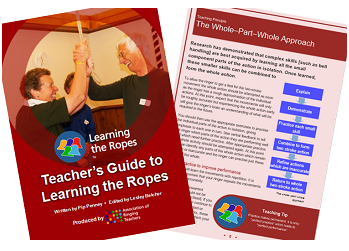Combining strokes
Putting both strokes together
Having got your novice ringer ringing the separate strokes proficiently, it is always a little nerve-racking handing over control of the bell so that they can put both strokes together.
Before you start, it is a good idea to adjust the length of the tail end so that the bell is rung under the balance, taking the pressure off the novice if they fumble or miss the sally and reducing your stress levels too!
A good place to start is for the novice to ring all the backstrokes with the handstrokes being introduced gradually – starting with just one. Which one depends on you and your novice ringer.
You can ask your ringer to ring the handstroke directly after the bell is pulled off, which is a natural place to start if your ringer has just mastered the handstroke pull off on its own, with you ringing the backstroke. In this case the novice ringer would begin by pulling off the first handstroke, transferring their hands onto the tail end and ringing the backstroke whilst you deal with all the following handstrokes.
Once the handstroke pull off and following backstroke is perfected ask the novice to catch ONE moving sally i.e. the novice pulls off at handstroke, rings the backstroke, catches one moving sally, the handstroke, rings the backstroke and you catch the next moving sally. Once perfected ask them to catch two consecutive moving sallies … but by now you may be already forgetting how many sallies you have told them to catch - is this next one yours or theirs? This is where regular patterns and verbal prompts become really useful.
You can ask your novice to ring every backstroke but only alternate sallies. Saying clearly after each handstroke - ‘yours’, ‘mine’, ‘yours’, ‘mine’- so everybody is clear about who is going to catch the sally next. A pointed finger can also act as a visual prompt to reinforce whose sally it is next. Progress from this to the novice ringing two consecutive sallies and you ringing one. So after each handstroke, remind them aloud - this is your first sally, your second sally, this one is mine. Then the novice can move on to their ‘first of 3’, ‘second of 3’, third of 3’ and ‘mine’.
Alternatively, you can agree upfront a verbal prompt or instruction. For example, that stroke number 1 is ALWAYS the teachers and that you will count the handstrokes loudly & backwards. Then when their hands are on the sally to pull the first handstroke identify that as stroke no 3, the next handstroke is stroke number 2, and the last sally belongs to you. Then all you do is count - backwards - from a greater number and everyone knows whose sally is whose as you are always responsible for stroke number 1.
When you catch the sally, you can feedback to the ringer how powerful/underpowered it was when you caught it. You catching the occasional planned sally will give the ringer comfort/breathing space and will allow you to ‘get things back on track’ if there is any lack of control. The novice ringer will also be able to remind themselves of the feel of a good long straight down draw on the backstroke when they aren’t responsible for the sally and hopefully they will carry that on when they have to catch their own sally too!

Teacher's Guide to Learning the Ropes
A book for any ringing teacher, covering the “how to” from the first bell handling lesson to teaching someone how to ring their first method.
The Teacher's Guide and its companion publication The Ringer's Guide to Learning the Ropes are both available from the ART shop.
Helen McGregor